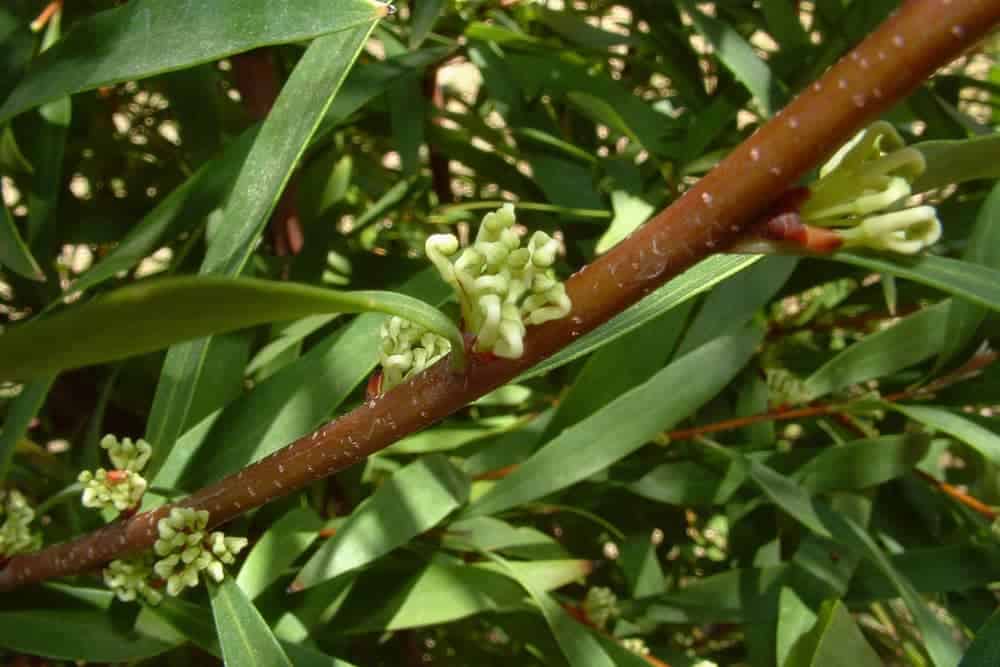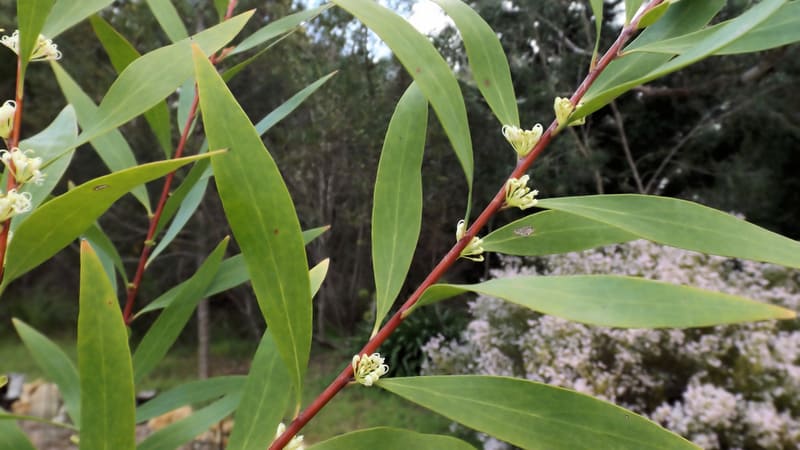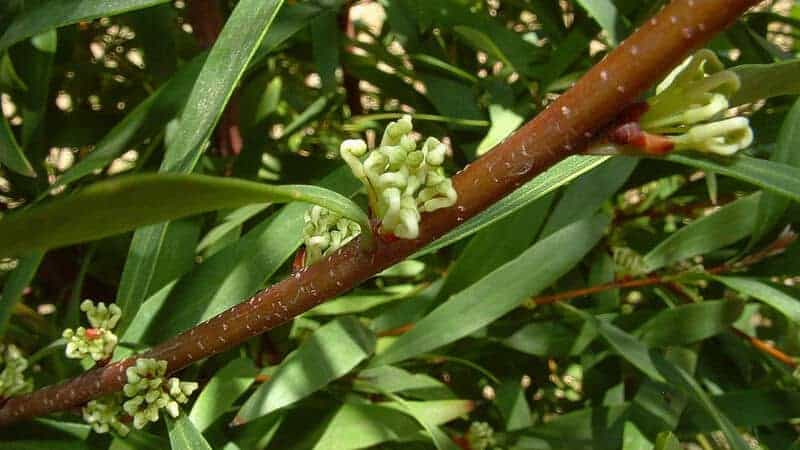Are you looking for a green alternative to fences and concrete walls? There are plenty of thick Australian shrubs that double as privacy screens — and one of them is a tough-as-nails native plant that’s practically indestructible.
Can’t wait to learn about this larger-than-life garden favourite? It’s time to get up close and personal with the hardball Hakea with a big reputation — the Hakea Salicifolia.
An overview of the Hakea Salicifolia
One look at the Hakea Salicifolia and you’ll know you have a heavyweight botanical in your hands. Standing between 4-5m in height and measuring 3-4m in width when fully grown, the Hakea Salicifolia is larger than most shrubs. A mature plant can pass as a small tree if left unpruned. The Hakea Salicifolia, after all, is a fast grower and by no means delicate. You’ll likely see this plant thriving in your garden for years.
Resistance to fire and the ability to grow under harsh conditions are among this shrub’s superpowers. With its hardy nature and formidable structure, the Hakea Salicifolia — along with other Hakea species such as the Hakea Nodosa, Hakea Decurrens, Hakea Laurina, and Hakea Petiolaris — is a force to be reckoned with.
Geography
The Hakea Salicifolia has two signature traits that it shares with many native Australian trees: fast growth and a hardy nature. Well-loved locally, the Hakea Salicifolia is endemic to Eastern Australia. You can find plenty of the Salicifolia subspecies from Springbrook, Queensland to Jervis Bay, New South Wales. Hakea trees of the Angustifolia subspecies, on the other hand, grow near aquatic environments between Hornsby and Helensburgh in New South Wales.
Structure
The Hakea Salicifolia is known for its dense habit that presents a round form if pruned regularly. Newly sprouted shoots have sparse silky hairs on them. Over time, the young shoots develop into woody branches with red ribbing — these stems hold the foliage that makes this species famous.
Leaves
Thank your lucky stars the Hakea Salicifolia is a bushy shrub with evergreen foliage — its leaves are beyond beautiful and deserve to be displayed all year long. One look at its eye-catching willow-like fronds and you’ll know why it’s rightfully named the ‘Willow Leaf Hakea’ or the ‘Willow-leaved Hakea’.
Mature leaves are narrow and oval-shaped, with a lovely pale green colour tinged with a bluish tint. New growth, on the other hand, presents a darker shade of green. Foliage texture is matte — not glossy — and highlights the Hakea Salicifolia’s elegant leaf colour.
Flowers
Hakea Salicifolia shrubs aren’t just leafy beauties — they’re also known for their dazzling white or pale yellow flowers that come in clusters. Each cluster is made up of 16-28 blossoms, all neatly attached to a short stalk.
Depending on your plant’s living conditions, it can take between 4-5 years before you get a lush inflorescence. Await these gorgeous blooms during winter and spring, as the flowering season happens around this time of year.
Gardening tip: For profuse blooms, check that your Hakea Salicifolia isn’t receiving too much nitrogen. Nitrogen can deter your shrub from producing flowers by inducing leaf growth instead.
Fruit
Floral cut arrangements don’t need to be boring when you have Hakea Salicifolia fruits in your garden.
Simply cut off a stem containing one of this Hakea’s woody egg-shaped fruits and place it in a vase along with other native Australian flowers — you’ll have a smashing home ornament in an instant.
Gardening uses of the Hakea Salicifolia
The hardy but captivating Hakea Salicifolia looks great on its own or with other plants in your garden. It is ornamental enough to be a stand-alone tree, but you can mix it with other sun-loving Australian native plants for a dramatic effect.
Take advantage of the Willow-leaved Hakea’s breathtaking foliage and use it as an effective wind-break or privacy screen. Hakea Salicifolia shrubs make for dense hedges that block your neighbour’s view of your backyard.
It’s not surprising to find birds and bees flying about when you have a Hakea Salicifolia in your garden, either. This Hakea variety attracts garden animals because of its shade and profuse flowering.
Gardening tip: For a thick Hakea Salicifolia hedge, space the shrubs at least 1.5-2m apart. Planting your shrubs this way will give you plenty of privacy in your garden and ample space for your Hakea to grow.
Hakea Salicifolia maintenance
When growing and maintaining Hakea Salicifolia plants, it’s important to remember two things: 1) these shrubs grow fast and 2) they can survive just about anything nature throws at them.
Environmental conditions needed for growing Hakea Salicifolia
Hakea Salicifolia plants love the weather conditions in coastal areas and thrive where there is abundant sunlight and well-draining soil. These are all you need to keep your scrubs healthy and vital-looking:
- Light requirements. Position your Hakea under full sun — your plant needs plenty of sunlight to grow well.
- Planting. The Willow Leaf Hakea can grow in most soils. It is at its best however when planted in well-drained soil. Plant during late winter or spring to boost its growth.
Water your shrub regularly for optimal growth, but take care not to overwater. Fertilising is not a must, either. Give your plant these environmental conditions and you’re pretty much set!
Maintaining your fast-growing Hakea Salicifolia
If grown under the right conditions, your Hakea Salicifolia is in for the long haul.
There’s no stopping this native shrub from growing — some gardeners report that their Willow-leaved Hakeas can survive beyond 10 years of age.
It doesn’t hurt the Hakea’s chances of survival that it is frost-tolerant and fire-resistant, either.
- Watering: Hakeas in general don’t need much water once established. A regular watering every 1-2 weeks is enough to ensure that your plant stays hydrated.
- Pruning: Cut back 20%-30% of the Hakea’s foliage to encourage new growth. The best time to prune your plant is after flowering — do this annually and you’ll have a nice thick hedge in your garden.
Gardening tip: Turn your Hakea Salicifolia into a privacy screen by pruning the tips — doing this keeps the habit dense and nicely formed.
Common Hakea Salicifolia problems and how to treat them
The Willow-Leaved Hakea has the qualities of a small tree — it is sturdy and can withstand harsh environmental conditions.
However, it can become susceptible to pest infestation and fungal disease as it ages. Here are some issues you may deal with while growing this variety in your garden:
Overgrowth
The Willow-leaved Hakea is a shrub or small tree that can grow at least a metre in height each year. This plant can take up a lot of space, which is a good thing if you want to fence your backyard in. An unruly Willow-leaved hakea is another matter, however.
If you’re the type of gardener who prefers their outdoor space neat and tidy, it’s helpful to set aside time to give your shrubs an annual prune. Regular pruning ensures that Hakeas stay dense and compact.
Busy owners of Hakea shrubs find that using professional hedge trimming services is a more convenient option, as they get to have pristine-looking Hakeas all year round without stressing over the pruning, watering, and what-not.
Borers
In general, healthy hakeas aren’t susceptible to pests — not when they’re given adequate watering, sunlight, and soil nutrients. There are times infestation can’t be avoided, however, especially when there are borers in surrounding areas. Borers are the usual culprits of ill-looking fast-growing native trees, but they are fairly easy to treat.
When your Hakea is starting to look weak and unhealthy, check your shrub’s branches for any sawdust accumulating around holes — these are telltale signs that borers have dug tunnels into your Hakea’s stems.
You can remove the borers by inserting a piece of wire into the hole, or by sealing the hole with plastic wood. It’s usually easy to treat borer issues on Hakeas, but if the infestation is becoming a challenge to manage, you may need to call for pest control services.
Yellowing leaves
Yellowing leaves on your Hakea shrub can be a sign that you’re giving it too much water. What you want to do is cut back on the frequency of watering and see if the leaf colour returns to normal.
Iron deficiency is another thing to watch out for when Hakea leaves turn yellow. You can fertilise your Hakea with a low-phosphorus, slow-release native fertiliser to give your shrubs a nutritional boost.
You may also want to check the amount of sunlight your plant is receiving — too little sunshine can impede your Hakea from producing enough chlorophyll, which gives it its dazzling green colour.
Remove large branches or other types of shade that may be blocking off the sun’s rays to let sunlight through. Your Hakea will be back to its bright and chirpy self in no time.





